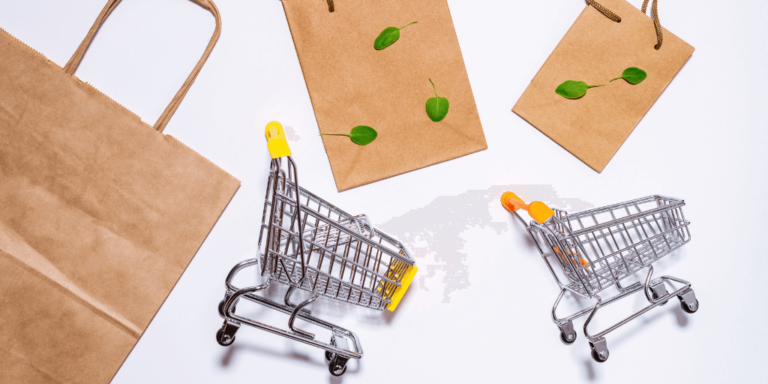As climate change policy impacts people worldwide and the global consumer base shifts to a younger demographic, brand sustainability is becoming more important. Modern consumers expect brands to take responsibility for responding to climate change. They’re also willing to pay extra to protect the environment.
ECommerce Packaging Is a Major Source of Waste
Single-use plastic packaging is a significant source of global plastic waste. Many nations have introduced tighter regulations around the use of plastic packaging.
- Several European nations restrict and even ban plastic and styrofoam in packaging and manufacturing.
- China has upgraded its restrictions on single-use plastic to a ban.
- India is promoting biodegradable plastic alternatives.
- New York has joined the list of US states enforcing plastic bag bans.
As plastic regulations get stricter around the globe, eCommerce businesses will have no choice but to explore eco-friendly packaging materials. Read on for a few environmentally friendly packaging ideas.
1. Use Less Packaging
The fastest, easiest, and cheapest way to make your packaging more eco-friendly is by using less packaging in general. Find a way to package and ship your products with fewer materials, and impress your customers with better sustainability practices. You may even save money on shipping.
Custom packaging that doubles as a shipping container is a great way to save money and the environment. The old way often involved double or triple packaging products in individual bags, small boxes, and poly mailers. Instead, consider packing and shipping your goods in sturdy, sectional boxes that can double as storage for the customer.
2. Reusable or Returnable Packaging
Another great way to make your packaging more eco-friendly is to make it reusable — or even returnable. Many consumers reuse large, sturdy cartons, boxes, jugs, or jars to store things around the house. Some even upcycle containers into crafts and sell them as art.
An alternative to reusable packaging is returnable packaging. Returnable packaging was prevalent several decades ago. Recently, it has started to make a comeback as a way to extend the life cycle of raw materials.
3. Mono-Material Packaging or Recycled Packaging
If reusable or returnable packaging isn’t an option for your brand, easily recyclable mono-material packaging may be the solution. A primary reason packaging ends up in a landfill is that many composite materials can’t be easily recycled. By simplifying the raw materials in your packaging, you can increase the likelihood that your packaging gets recycled after use.
To be even more environmentally friendly, you can use 100% recycled packaging. Using packaging made from recycled plastics or other recycled materials can reduce pollution and serve your customers better.
4. Biodegradable Bio-Based and Plant-Based Packaging
As more brands move away from plastic packaging, many bio-based and plant-based packaging alternatives are entering the market.
- Plant-based packing peanuts and other loose materials (styrofoam alternative)
- Plant-based inks and dyes (plastic ink alternative)
- Corrugated cardboard or paper bubble wrap (plastic bubble wrap alternative)
- All-natural kraft mailers and envelopes (poly mailer alternative)
- Organic fabric packaging (plastic bag alternative)
Paper made from wood pulp was the original biodegradable packaging material, but not all wood pulp comes from FSC certified sources. Several alternative plant-based paper and plastic replacements have entered the market:
- Cornstarch packaging
- Organic bamboo packaging
- Mushroom packaging
- Organic or recycled cotton packaging
- Seaweed packaging
- Coffee packaging
- Organic hemp packaging
5. Compostable Packaging and Plantable Packaging
While all compostable packaging is always biodegradable, not all biodegradable packaging is compostable. There are many compostable alternatives for common types of packaging, but not for all kinds. So if you want to upgrade to compostable packing materials, you may need to rework your packing and shipping procedures.
Similar to compostable packaging, some brands have switched to plantable packaging. Plantable packaging is typically made of Kraft paper or cardboard with embedded seeds. They can be planted in the ground and grown as plants if consumers follow planting instructions.
Edible Packaging
There’s one final alternative form of packaging worth trying for the most adventurous brands out there: edible packaging. This type of packaging is best for fresh foods like prepared sandwiches. Still, it also sees some use in water pods (edible bottle alternatives) and packaged snacks.
Invest in an Eco-Friendly Packaging Solution Today
Going green requires an investment of both time and money. The consumer landscape is shifting fast, so you don’t want to fall behind the competition with wasteful plastic packaging. Don’t let slow payouts from eCommerce marketplaces hold back your plans to make your business more environmentally friendly.
Payability offers swift, flexible funding solutions for eCommerce businesses ready to scale. Instant Access provides accelerated daily payouts for marketplace sellers, and Instant Advance provides up to $250k in funding for eCommerce growth.
Payability’s solutions are fast and convenient for every type of eCommerce business:
- Fast Approval: Skip the credit check and apply online to get approved and funded in as little as one business day
- Easy Transfers: Access your funds whenever you need them with Instant Transfer, Same Day ACH, or wire
- Earn Cash Back: Get up to 2% cash back on each purchase you make with the Payability Seller Card


